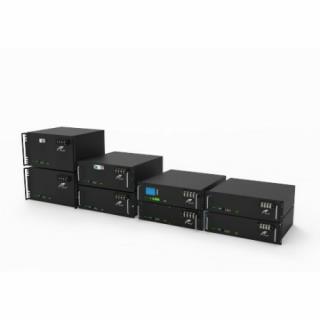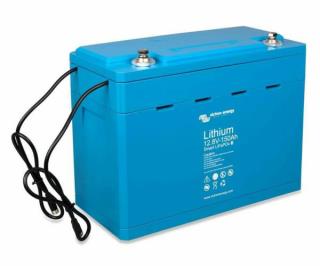El sol es nuestro aliado
Baterías solares de ciclo profundo
CODESOLAR
ENERGIA
S. A.
Baterias Li-Ion litio Ion
CSE

CodeSolarEnergia S. A.
Quito, Ecuador, Sudamerica
Lithium (sealed) or maintenance free.
- They are lighter than lead acid ones.
- They accumulate more energy per weight and in many cases also more energy per volume compared to batteries made of other materials.
Lithium-Ion Batteries
The market for battery systems is developing very rapidly. The demand for efficient batteries with high energy density is growing. Victron Energy has the right answer to this demand: The Victron Lithium-Ion battery system. This system consists of a very modern battery with an advanced control and safety system: the so-called "Battery Management System" (BMS - battery management system). The BMS controls both charging and discharging, immediately taking action when certain (crucial) values are exceeded and thus safeguarding the efficiency of energy transfer.
Lithium ion battery
The lithium ion battery, also called Li-Ion battery, is a device designed for storing electrical energy that uses a lithium salt as an electrolyte that provides the ions necessary for the reversible electrochemical reaction that takes place between the cathode and the anode. .
The properties of Li-ion batteries, such as the lightness of their components, their high energy capacity and resistance to discharge, together with the little memory effect they suffer or their ability to operate with a high number of regeneration cycles, have made it possible to design lightweight, small-sized batteries of various shapes, with high performance, especially adapted to the applications of the consumer electronics industry7 Since the first commercialization of an accumulator based on Li-ion technology in the early 1990s, Its use has become popular in devices such as mobile phones, electronic agendas, laptops and music players.
However, its rapid degradation and sensitivity to high temperatures, which can result in its destruction due to inflammation or even explosion, require, in its configuration as a consumer product, the inclusion of additional safety devices, resulting in a higher cost that has limited the extension of its use to other applications.
At the beginning of the 21st century, in the context of the growing cost of petroleum-derived fuels, the automobile industry announced the development, proliferation and commercialization of vehicles with electric motors based on lithium-ion battery technology, with which Energy dependence on these sources can be reduced while the emission of polluting gases is kept low.
Disadvantages
Despite all its advantages, this technology is not the perfect system for energy storage, as it has several defects, such as:
Average duration: depends on the amount of charge they store, regardless of their use. They have a useful life of about 7 to 10 years or more if stored with 40% of their maximum charge (in reality, any battery, regardless of its technology, deteriorates if stored without a charge.
Just remember the sulfation process that occurred in old zinc-carbon batteries when they were stored when completely discharged)
.
They support a limited number of charges: between 300 and 2000, the same as a nickel cadmium battery and more than Ni-MH batteries, so they are now beginning to be considered in the consumable category.
s.
They are expensive: their manufacture is more expensive than Ni-Cd and the same as Ni-MH, although the price is currently falling rapidly due to its great penetration in the market, with the consequent reduction in price. We can say that they are used in all mobile phones and laptops in the world and their use continues to extend to all types of low-power portable tools.
They can overheat to the point of exploding: they are made of flammable materials that make them prone to detonation or fire, which is why it is necessary to equip them with electronic circuits that control their temperature at all times.
Worse cold work capacity: they offer lower performance than Ni-Cd or Ni-MH batteries at low temperatures, reducing their life by up to 25%.
Very variable voltage: because the variation in cell voltage is very large, it is essential to use a small DC/DC converter depending on the application in question if you want to have a constant output voltage.
As the production of Lithium batteries is advancing, new technologies must be verified.
Minimal memory effect.
Linear discharge: throughout the discharge, the voltage varies greatly: if the nominal voltage of a lithium cell is 3.6V, the maximum voltage will be around 4.2V, while the minimum recommended voltage is 2.5V to avoid deep discharge of the battery and reduction of its useful life. This means that the variation of the cell voltage with respect to the state of charge is constant. That is, the slope of the dV/dC line is constant (if represented graphically, the voltage as a function of the discharge is a straight line). This makes it easier to know with good precision the state of charge of the battery.
Long life in professional batteries for electric vehicles. Some manufacturers show data of more than 3,000 charge/discharge cycles for a capacity loss of 20% at C/3.
Ease of knowing the load they store. Simply measure the battery voltage at rest. The stored energy is a function of the measured voltage.
Very low self-discharge rate: when we store a battery, it progressively discharges even if we do not use it. In the case of Ni-MH batteries, this "self-discharge" can amount to more than 20% per month. In the case of Li-ion it is minus 6% in the same period. Many of them, after six months of rest, can retain 80% of their charge.
Combinations
It must be taken into account that there are numerous combinations of lithium on the market, which can lead to many different characteristics. Among them we find:
Polymer lithium-ion batteries,17 in which the main difference from ordinary lithium-ion batteries is that the lithium-salt electrolyte is not contained in an organic solvent, but in a solid polymeric compound such as polyethylene oxide or polyacrylonitrile. The advantages of polymer lithium over lithium-ion are: lower manufacturing costs, adaptability to a wide variety of packaging forms, reliability and strength.
Lithium iron phosphate (LiFePO4), also known as LFP.18 Compared to traditional lithium ion batteries, in which LiCoO2 is one of the most expensive components, lithium iron phosphate batteries are significantly cheaper to produce.
The lithium iron phosphate olivine type. They have the characteristic that they can last about 10 years if charged once a day. In addition to having a long life, they can be charged very quickly, since they only take two hours to reach 95% of their capacity. Among others, it is marketed by Sony Business Solutions (ESSP-2000)
Battery care
These batteries have the lowest memory effect of all other technologies,14 which is why it is necessary that after a number of incomplete cycles a complete calibration of the battery is carried out so that the memory effect disappears. To extend their useful life they need certain care:
It is not true that it is beneficial to let the battery discharge periodically. On the contrary, it can impair effectiveness. It is best to avoid the charge dropping below 15%.
It is recommended that they remain in a cool place (15 °C) and avoid heat. They are very sensitive to temperature; Leaving them in the sun and humidity decreases their performance.
When they are going to be stored for a long time, it is recommended to leave them with an intermediate load (40%). Likewise, you should avoid keeping them fully charged for long periods.
The first charge is not decisive in terms of its duration nor is it necessary to do so; The performance of a lithium ion battery on the first charge is the same as the subsequent ones. It is a myth probably inherited from nickel batteries.
It is necessary to charge them with a specific charger for this technology. Using an improper charger will damage the battery and may cause it to catch fire.
To recharge, it is not essential to use a specific charger for the brand and model of the device (despite being ideal, it is also expensive). Any good quality charger that meets the electrical characteristics of the device can be used.
Most of today's devices have intelligent behavior. In other words, they can detect when their batteries are fully charged to automatically disconnect them and divert current to the rest of the device.
There are special fireproof bags where you can store them, since these batteries are very delicate.
Advantages
Commercial Li-ion battery.
This technology has become the most interesting in its class for use in laptops, mobile phones and other electrical and electronic devices. Mobile phones, electronic diaries, and even new MP3 players come with batteries based on this technology, thanks to its several advantages:
A high energy density: they accumulate much greater charge per unit of weight and volume.
Low weight: for the same stored charge, they are less heavy and take up less volume than the Ni-MH type and much less than the Ni-Cd and lead ones.
Great discharge capacity. Some Li-ion batteries - the so-called "Lipo" Lithium-ion Polymer (lithium ion in polymer)16 - on the market can be fully discharged in less than two minutes.
Low thickness: they come in rectangular plates, less than 5 mm thick. This makes them especially interesting to integrate into portable devices that must be thin.
High voltage per cell: Each battery provides 3.7 volts, the same as three Ni-MH or Ni-Cd batteries (1.2 V each).
Standards
The IEEE has established the standards:
1625 laptop batteries.
1725 mobile phone batteries
1825 photography or video camera
batteries.
About lithium batteries
Lithium-air battery
Lithium-sulfide battery
Lithium titanate battery
Lithium iron phosphate battery
Lithium polymer battery
Nanoarchitectures for lithium-ion batteries
nanoball battery
Nanowire battery (lithium ion-silicon battery)
Solid State Lithium Ion Battery
Thin film rechargeable lithium battery
Lithium ion capacitor
Lithium
Valence Technology
Other metal ion batteries
aluminum ion battery
potassium ion battery
sodium ion battery
Lithium batteries
LiFePO4 LFP


